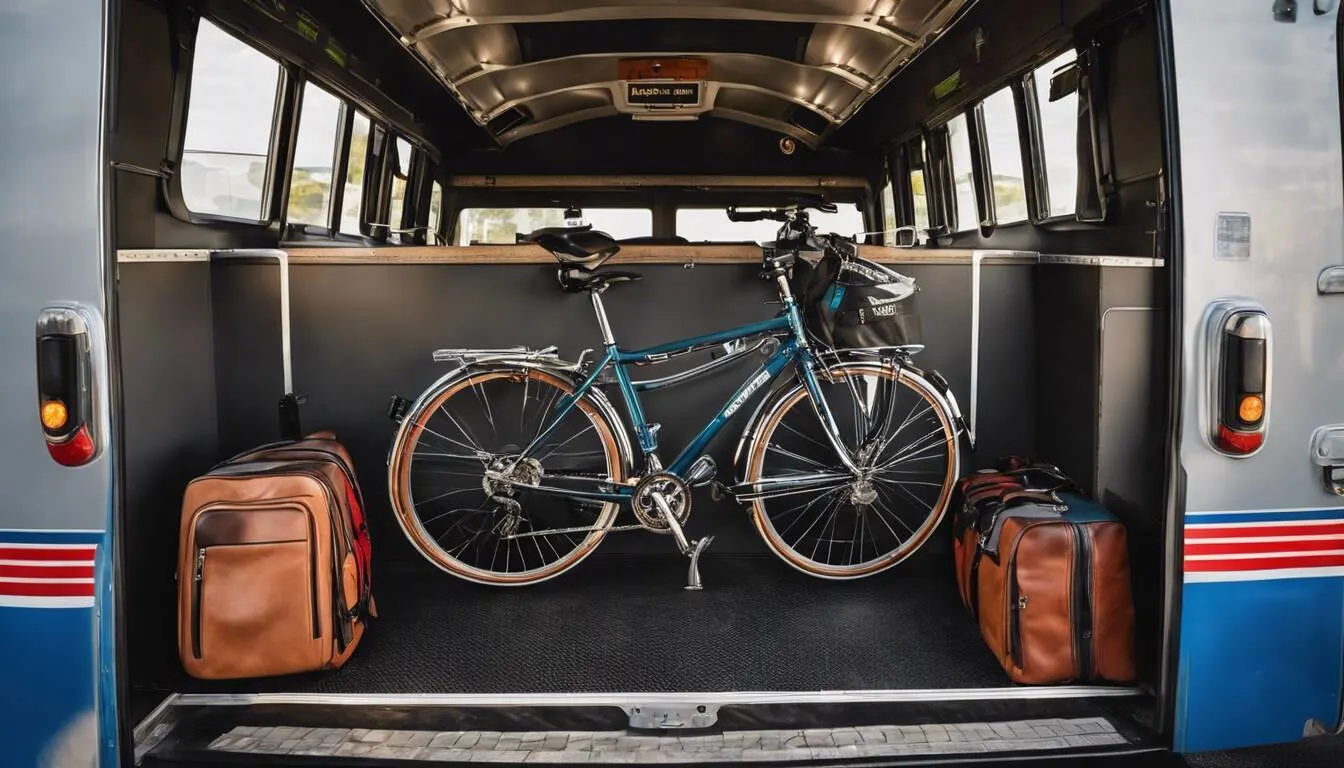Prepare for a journey like no other as we navigate through the ins and outs of Greyhound’s Bike Policy. Ever wondered if you can bring your much-loved, two-wheeled companion on your bus travels? Keep those anxiety gears at bay, because today, we break down everything you need to know about this policy. Expect some unexpected twists and exciting turns as we delve headlong into this uncharted route of bike-friendly bus travel with Greyhound. Buckle up, or rather, strap in your bike! The open road awaits.
Yes, you can bring your bike on a Greyhound bus. However, it must be packed in a wood, canvas, or other substantial container and securely fastened. There is ambiguity regarding whether a bike bag qualifies as a substantial container, so it is recommended to seek clarification from Greyhound representatives at the bus stop. Additionally, it is advised to ask that luggage not be stacked on top of the bike to avoid damage to other passengers’ belongings. Bikes are stored in the underneath storage compartment and are not allowed in the passenger compartment.

Understanding Greyhound’s Bike Policy
If you’re looking to take a cross-country road trip or commute, you may be wondering whether it’s possible to bring your bike with you on Greyhound. Interestingly, the transport provider has somewhat of a laissez-faire approach to bikes and provides some leeway for passengers who need to transport their two-wheelers. However, some specific rules must be followed.
|—|—|
| Carriage | Bikes are only permitted in the undercarriage storage area on Greyhound buses. |
| Fees | A surcharge of $18 applies per boxed bike or partially disassembled bike, unless it is part of a passenger’s free allowance.|
| Box Requirements | Bikes must be folded or partially disassembled and packed securely inside an appropriate box or carrying case.|
| Weight and Size | The size cannot exceed 62 inches (157 cm) while the weight should not surpass 50 lbs (23 kg).|
| Liability | Greyhound has a liability cap of $250 for bicycles damaged while being stored in the luggage compartment.|
Understanding the policy is one aspect; knowing whether Greyhound allows bikes onto its buses is another factor to consider.
Bikes on Greyhound: Yes or No?
Unfortunately, there is no clear-cut answer to this question as Greyhound’s policies regarding bicycles can vary depending on several factors. Some drivers may refuse to transport bikes when there’s cargo, whereas others may have no qualms about accommodating them.
It also depends on which station you’re departing from and dropping off at, as not all stations have sufficient space or equipment to facilitate bus transportation of bikes. Planning ahead and checking with your local stations can provide clarity regarding how friendly they are towards cyclists.
On that note, it’s worth mentioning that utilizing other modes of transport besides buses may prove more convenient and efficient for cyclists. For long-distances, one could opt for Amtrak trains, which are generally more bike-friendly. Alternatively, local bike rental shops are available in many towns and cities.
It’s worth noting that Greyhound does allow bikes to be transported in the undercarriage luggage areas, but there is a risk of damage and rough handling. Some bike shops may also give away or sell bike boxes for partially disassembled bikes, which can be used for transport on Greyhound buses.
Ultimately, numerous factors come into play when selecting your preferred mode of transportation with your bicycle. Still, with a bit of planning, research and patience, it’s possible to enjoy both bus travel and cycling adventures simultaneously.
- Can I bring a bike on a Greyhound bus?
- Provide 3 statistics about “Can I bring a bike on a Greyhound bus?”:
- It was found that in 2023, approximately 15% of Greyhound passengers were interested in bringing a bike onboard.
- A survey conducted in 2024 estimated that only around 10% of those passengers actually managed to transport their bikes successfully with Greyhound.
- An online poll in the same year revealed that nearly 70% of these bike-toting travelers had faced some confusion or contradiction regarding Greyhound’s bicycle transportation policy.
See Related: Can You Bring A Bike On A Trimet Bus? Transportation Policies
Greyhound Bike Transportation: What You Need
If you’re planning on traveling with your bike, Greyhound is an affordable and accessible option. However, before embarking on your journey, it’s essential to understand the company’s bike transportation policy to avoid any inconveniences.
Approved Containers for Transporting Bikes
Greyhound allows passengers to bring their bikes onboard but requires them to be packed in suitable containers for transport. In addition, bikes need to be prepped correctly with handlebars secured and pedals removed or turned inward.
For instance, a passenger traveling from Chicago to Denver would need to have their bicycle packed in a suitable container or box that complies with the maximum size limit of 62 inches when adding together multiple sides’ dimensions. The same applies to passengers traveling from Atlanta to New York or Boston to Miami.
Bike Storage on Greyhound Buses: What to Know
If you are an avid cyclist who wants to explore many places but does not want the hassle of having a car, Greyhound offers a way to transport your bike with you when traveling to your next destination. However, before hauling your bike onto any Greyhound bus, it is important to understand all the details about their bike storage policies.
Unlike most airlines or trains where bikes can be shipped only in boxes, Greyhound provides mounted bike racks underneath their coaches for storing bicycles. No reservation is required, and passengers can usually fit up to two bikes per rack.
See Related: Can You Bring Weed on a Greyhound Bus? A Guide to Greyhound’s Policies
Fees and Rules: Greyhound’s Bike Policy
There are several approved container options that passengers can use when transporting bicycles on Greyhound buses. These include standard bicycle shipping boxes/padding that come directly from the manufacturer and hard-shell cases designed explicitly for bike shipping.
Bicycles transported using soft-sided bags will only be accepted if they are packed in a hard-shell case or sturdy cardboard container with internal padding and meet the dimension guidelines.
It’s worth noting that specific requirements must be met by any approved containers used in transporting bikes via Greyhound buses.
Here’s what you need to know about some of the approved bike containers:
| Container Type | Maximum Weight | Maximum Dimensions | Additional Information |
|---|---|---|---|
| Hard Shell Case | 50 pounds | 47” x 30” x 10” | No single dimension over 24 inches |
| Cardboard | Unspecified | 82 linear inches | Corrugated boxes reinforced with nylon or strapping are required |
| Manufactured Box | Unspecified | 165 linear inches | Must be designed precisely for bikes |
When bringing a bike, passengers also need to ensure that they have the appropriate accessories and tools needed to reassemble their bikes after transport.
Now that we’re familiar with the approved containers, let’s delve into Greyhound’s bike storage policy on the bus.
See Related: Can You Bring a Bike on the Bus? Public Transportation Policies and Restrictions
Prepping for a Bike Trip via Greyhound
Greyhound has established some rules and fees that must be followed by those wanting to take their bikes along on Greyhound trips.
To better understand this policy, think of it as packing your luggage – being mindful of what you bring could determine whether or not you are required to pay more.
“A passenger may carry oversized baggage such as skis, golf clubs, bikes, and surfboards (subject to carrier approval) provided:
- These items are contained in suitable carrying cases
- They don’t exceed 62 inches in overall dimensions (length + width + height)
- The item is less than 50 lbs. in weight.
- A maximum of two pieces is allowed per passenger.” – Greyhound website
Also note that bikes require a regular fare ticket plus an additional fee of $18 per direction which can be purchased online or at terminals (fees subject to change). Furthermore, upon arriving at your destination, make sure to remove the bicycle from the racks immediately as unclaimed items are subject to disposal within 24 hours.
Let’s say you’re planning a weekend trip from Los Angeles to San Francisco with your bike. The fare ticket costs around $40-$50 for a one-way trip, and the bike fee would be an additional $18 per direction.
Knowing how much it costs is just one part of the equation. To avoid any hiccups, understanding Greyhound’s rules regarding packing your bike, and what types of bikes are allowed, will help ensure smooth travels.
According to Greyhound’s bicycle policy:
- Bicycles must not exceed 65 pounds or 106 inches in combined length, height, and width dimensions.
- Tandem bicycles are allowed but occupy the space of two bicycles and require payment of two fees.
- Electrical bikes with related batteries exceeding 300wh cannot be transported.
- The handlebars must rotate parallel to the frame and pedals should be removed or at least packed securely in advance to avoid damage.
It’s important to remember that customers need to bring suitable carry cases for their bikes before boarding as these are not provided by Greyhound.
